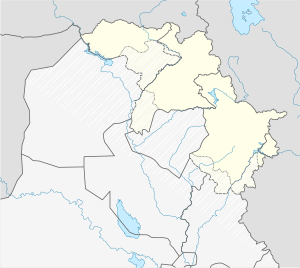Araden
Araden (Syriac: ܐܪܕܢ)[2][3] is an Assyrian village in the Sapna valley.[4][5] It is located approximately 20-30 kilometers (12–19 miles) east of the city of Zakho The village of Inishk lies a few miles to the east, and the village of Bamerne is to the west, while Sarsing can be seen to the south. The name Araden means "Land of Eden" in Aramaic.[4][5] The village is vast, spanning over 18 kilometers and containing more than 150 homes, 3 churches and a cemetery.[6]
Araden | |
|---|---|
 | |
 Araden Location in Iraq  Araden Araden (Iraq) | |
| Coordinates: 37°6′20.24″N 43°19′6.68″E | |
| Country | |
| Autonomous Region | |
| Governorate | Dohuk Governorate |
| Government | |
| • Type | Lijna, Committee |
| • Mukhtar | Toma Gidde |
| Area | |
| • Total | 18 km2 (7 sq mi) |
| Elevation | 1,723 m (5,653 ft) |
| Population | |
| • Total | 200+ (estimate) |
Two of the oldest churches in Christianity, Mart Shmoni[7] and Sultana Mahdokht,[8] (which was established in 325 AD) are located in Araden. A newer church known as Libbat Isho was established in the 1980s as well.[9]
People
Famed Chaldean Catholic Bishop Francis Daoud (Dawood) of Araden was known for bravery and leadership during the Assyrian genocide for helping to save many Assyrians living in Northern Iraqi villages from death through bartering with the Turks and Kurds. He was confirmed a bishop of the Chaldean Catholic Church on February 24, 1910, and served until his death on October 1, 1939, and is buried and memorialized in an ancient church in the Dohuk region.[10][11]
Destruction and attacks
The village of Araden was burned to the ground by 700 government soldiers during the 1960s. The villagers were attacked by irregular Kurds under the leadership of Zabir Muhammad Zebari which resulted in several deaths. Dinkha Eshaya, who was the mayor of Araden, was assassinated in 1981. In 1987, the village was once again destroyed by the Ba'ath regime.[4]
Wildlife
Flora
Most of the village is covered by fruit and nut bearing trees. To the north, higher up on the mountain towards a region of the land called "Gozaneh", large walnut trees grow around one of the springs that comes from the mountain. Loquat trees grow on the land below Gozaneh, along with quince, citron, orange, apple, and lemon trees. Around the residential lands, mulberry, blackberry, raspberry, and plum trees grow towards the lower edge of the village. Down in the valley towards the church Sultana Mahdokht, grows an abundance of pecan trees. However the entire region of Araden is covered in almond trees. The non fruit bearing trees include Cyprus, Cedar, Pine, Oak and spruce. In recent years, the Kurdistan Regional Government has banned the cutting of trees without a license, so these trees are beginning to grow in abundance all over the region.[12]
See also
- Assyrian homeland
- Assyrian settlements
References
- KRG Cabinet. "The Kurdistan Region in brief". cabinet.gov.krd. Archived from the original on 2018-08-17. Retrieved 2018-08-17.
- "Assyrian languages". Retrieved 22 April 2020.
- "Araden". Retrieved 22 April 2020.
- Donabed, Sargon (2010). "Iraq and the Assyrian Unimagining: Illuminating Scaled Suffering and a Hierarchy of Genocide from Simele to Anfal" (PDF). University of Toronto: 217–218.
- Ishow, Habib (1979). "Araden ou le « Jardin du paradis ». La terre et les hommes dans un village chaldéen du nord de l'Irak". Études rurales. 76 (1): 97–112. doi:10.3406/rural.1979.2535. ISSN 0014-2182.
- Aradin village. "Aradin". www.ishtartv.com. Archived from the original on 2016-07-07. Retrieved 2016-06-24.
- Mart Shmune church. "Aradn Village". www.ishtartv.com. Archived from the original on 2016-08-27. Retrieved 2016-06-24.
- Sultana Mahdokht. "church in Aradn". www.ishtartv.com. Archived from the original on 2016-08-27. Retrieved 2016-06-24.
- Churches in Araden. "Galb Al Aqdas church – Aradn". www.ishtartv.com. Archived from the original on 2016-08-13. Retrieved 2016-06-24.
- Cheney, David M. "Amadiyah and Zaku (Diocese) [Catholic-Hierarchy]". www.catholic-hierarchy.org. Archived from the original on 2014-12-13. Retrieved 2015-02-10.
- Cheney, David M. "Bishop François Daoud (David) [Catholic-Hierarchy]". www.catholic-hierarchy.org. Archived from the original on 2015-06-26. Retrieved 2015-02-10.
- FLORA FAUNA. "The Kurdistan Region's flora and fauna". cabinet.gov.krd. Archived from the original on 2018-08-17. Retrieved 2018-08-17.